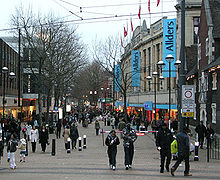Allders
[1] The chain was broken up and sold after it went into administration in 2005, although the Croydon store continued trading until 2012, having been purchased by Harold Tillman, the then-owner of the Jaeger clothing company.
His main residence in Pampisford Road, South Croydon, now houses Regina Coeli RC school, and two cul-de-sacs nearby are named Allder Way and Joshua Close.
Improvements during the 1950s included the takeover of a cinema auditorium as the gift department and the installation of Croydon's first escalators, built by J & E Hall, in 1954.
In the 1960s there was considerable change in Croydon, particularly the construction of the Whitgift Centre to the north of Allders, into which the store expanded, and the creation of the St George's Walk development.
Transport and lifestyle changes led to greater competition with the West End and further improvements were required to modernise the store.
[2] This process began with Shinners of Sutton in 1979 and later Hinds of Eltham, Medhursts of Bromley, James Page of Camberley, Mackross of Cardiff, Willis Ludlow of Hull and Landport Drapery Bazaar (LDB) in Portsmouth.
Only Arding & Hobbs at Clapham Junction in London, John Farnon in Newcastle upon Tyne and the Clover furnishing stores in Leeds city centre and Kirkstall retained their original identities.
A new geometric logo of ten orange 'A's arranged in a circle on brown and cream-coloured stationery, bags and carpets appeared across the group, together with the phrase "All that a great store should be".
The vast carpet department was contracted to a secondary location allowing for the creation of a new perfumery and cosmetics hall at the centre of the ground floor.
These stores were integrated into the Allders At Home portfolio and brought the brand to town centre locations in Bromley, Chelmsford, Crawley, Kingston upon Thames, Reading, Sutton Coldfield and Watford.
The Kingston store, offering a range focussed solely on furniture, beds and carpets, struggled to compete with Bentalls and John Lewis.
Nevertheless, it continued a policy of expansion, acquiring the premises of the former C & A stores at Guildford, Kingston upon Thames, Leicester, Sheffield (Meadowhall), and York in 2000 and later the large C & A building on the south side of Oxford Street in London.
Some felt at the time that Scarlett's bid was based on Minerva's intention to acquire Allders' site for its Park Place project, in order to sell the plot to another retailer, probably John Lewis.
It was claimed that some of the traditional homeware, haberdashery and clothing for middle-aged, middle-income women was reduced, with a new emphasis on young fashion and beauty products, though this was denied by Terry Green.
[4] In September 2004, Minerva announced that Allders had made a loss of £22.6m for the year to 30 June 2004,[5] blaming the speed of the transformation of the business.
Of Allders' 50 stores, only 35 received offers, with rival retailers such as House of Fraser, BHS, Debenhams and Primark said to have expressed an interest.
In the first year of operation the new managing director, Andrew MacKenzie, turned the fortunes of the company around and projected a £1 million gross profit.
[8] The land and store that Allders leased had regular break clauses to the benefit of the "virtual freehold leaseholder" held by Minerva plc subsidiary companies for 250 years.
[10] The administrators Duff & Phelps failed in their search for a new investor and Allders finally closed down after the last day of trading on 22 September 2012.
[11] It was reported in Scotland on Sunday that Metis, a Glasgow-based intellectual property firm were looking to sell brands that were owned by Allders.
[12] In July 2019, Croydon Council took possession of the site as part of the proposed redevelopment of the Centrale and Whitgift Centre shopping malls.

